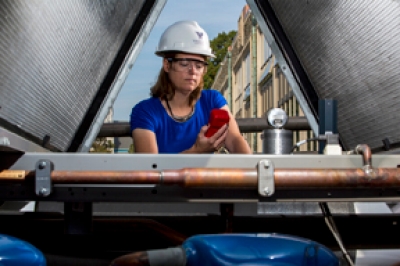Villanova Engineering Professors' Work to be featured in National Compendium

Professor Amy Fleischer, PhD, measures waste heat at the campus cooling towers.
Research on data center waste conducted in the Center for Energy-Smart Electronic Systems (ES2) at Villanova University has been selected for inclusion in the 2014 Compendium of Industry-Nominated Technology Breakthroughs. The compendium provides an overview of the outstanding work coming out of National Science Foundation (NSF) Industry/University Cooperative Research Centers (I/UCRC), and is provided to interested members of Congress, White House and congressional staffers, and members of official NSF committees of visitors. The ES2's inclusion—its first—will enhance the reputation of both the Center and Villanova's College of Engineering.
"Data Center Waste Energy Recovery and Re-Use" reflects the research of Mechanical Engineering Professor and Novatherm Laboratory Director Dr. Amy Fleischer (PI) and Dr. Gerard Jones, professor and senior associate dean for Graduate Studies and Research. In the compendium entry, Dr. Fleischer identifies data centers as a growing source of "waste energy," consuming more than 2 percent of the country’s total electricity usage. Given their high energy costs and depletion of limited resources, the capture and reuse of data center waste energy is of significant interest. "With the ever increasing demand for computing services in all sectors of the economy, and the rapid adoption and transition to cloud-based computation and storage, electricity demands will continue to soar over the next few years," writes Dr. Fleischer. Increased demand results in increased processing loads on data center servers, and increased loads lead to increased chip power, which can result in overheating. This heat must be removed from servers to maintain reliability and prevent system failure. The resulting coolant stream generates what is referred to as "waste heat." This waste heat is then often discharged directly to the environment though cooling towers.
Drs. Fleischer's and Jones' research focuses on identifying the most promising methods and technologies for utilizing the energy transferred to this coolant stream, rather than discharging it to the environment. Their breakthrough findings demonstrate realistically how companies can recover data center heat and re-use it in their own facilities, reducing overall energy consumption and cost. Using the optimized designs and operational models developed by Drs. Fleischer and Jones, organizations will be able to easily consider all options for energy re-use from their data center facilities and can expect reduced overall energy consumption and lower energy costs. "In addition, the contribution to global warming will be significantly reduced," notes Dr. Fleischer. "If applied globally, the industry will not only recognize significant financial savings, but will also avoid the potential negative public image associated with the rapidly growing energy consumption of IT facilities and their environmental impact."
All entries in this compendium were nominated by industry scientists and "exemplify the countless collaborative efforts of university and industry scientists and the economic impacts of the resulting research." The entire compendium and individual center entries will be downloadable from the NSF I/UCRC website by January 10, 2014.
About the Center for Energy-Smart Electronic Systems: The first research center of its kind funded by the NSF, the ES2 Center works in partnership with industry and academia to develop systematic methodologies for operating electronic systems and cooling equipment synergistically. The Center integrates research in all aspects of data center energy efficiency, "from the chip to the cooling tower." Villanova University is one of four ES2 sites, the others being Binghamton University, University of Texas Arlington and Georgia Institute of Technology. "Data Center Waste Energy Recovery and Re-Use" is one of three projects underway at Villanova.
